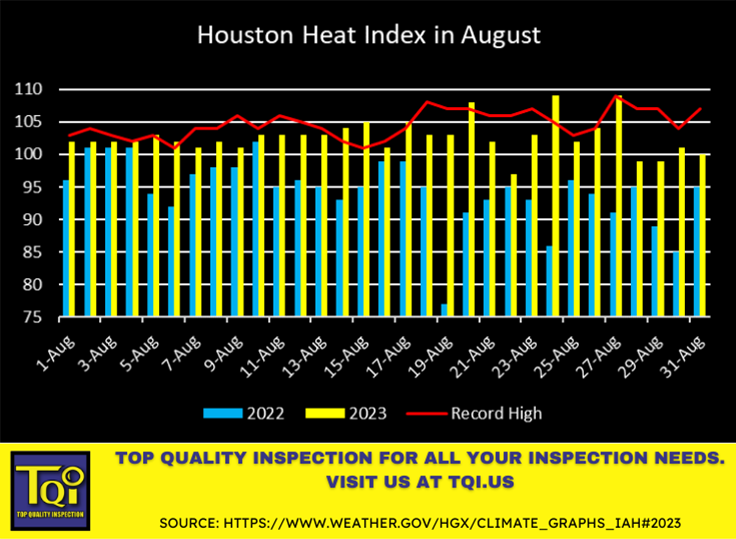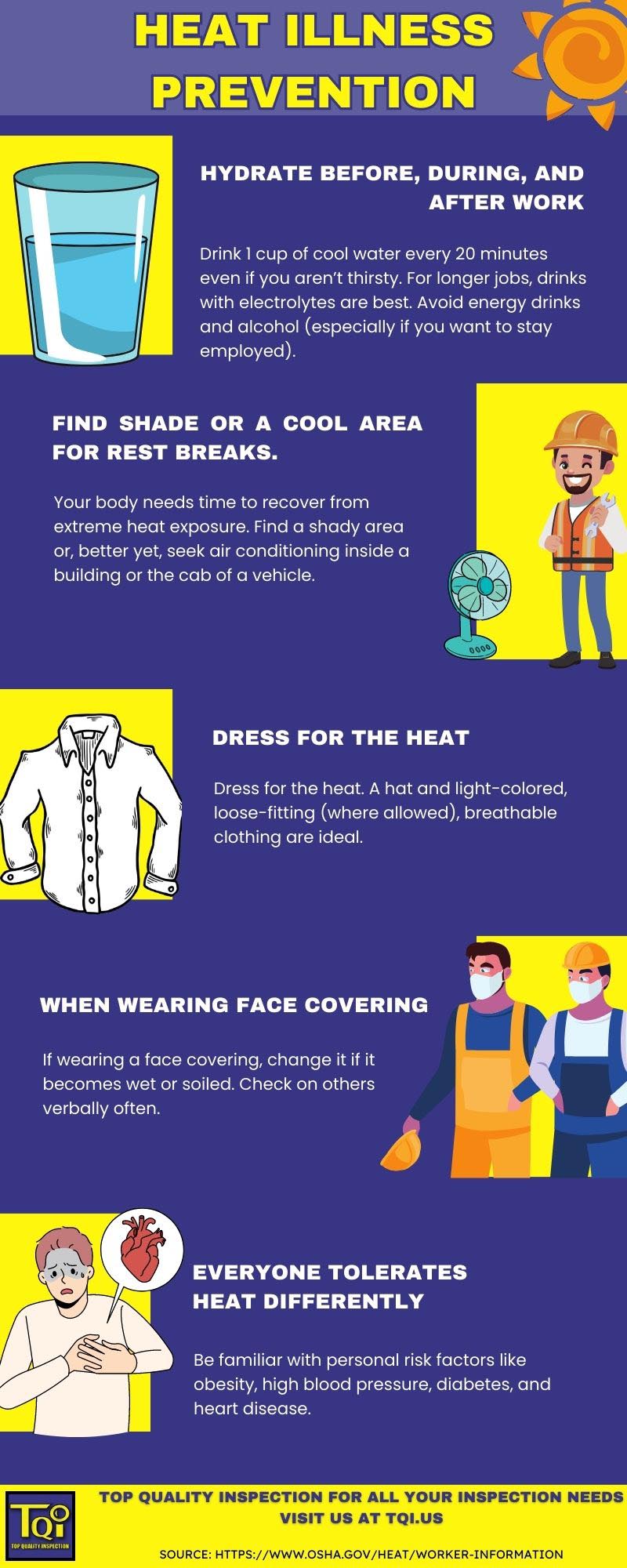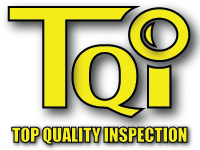Top Quality Inspection, or TQI, is headquartered out of Houston, Texas. The scorching hot month of August is finally over and the daily heat index temperature dipped below 100F on only three days. Rainfall is a distant memory at this point. There never been a better time to discuss heat illness prevention. Heat illness presents real risk to workers on the jobsite. Understanding the danger of heat illness can help us develop a plan to prevent it. This article explains what heat illness is and delves into effective strategies to stay cool and prevent heat-induced ailments. The recommendations shared here is in alignment with the Occupational Safety and Health Administration’s (OSHA) heat illness prevention guidelines.

What is Heat Illness?
Strenuous work performed while exposed to elevated temperatures and humidity can cause body temperature to rise rapidly to a danger level. High body temperatures can trigger various heat-related illnesses, including heat stress, heat exhaustion, and heat stroke, which can have severe consequences if not addressed promptly.
Heat Stress
Heat stress is a common heat-related illness that workers may experience on the jobsite. Symptoms may include profuse sweating, fatigue, dizziness, and nausea. It is important to be aware of the health risks associated with heat stress, such as heat exhaustion and heat stroke.
Heat Exhaustion
Heat exhaustion is another heat-related illness that workers may encounter sometimes resulting in heavy sweating, weakness, and confusion. If an individual experiences heat exhaustion, immediate actions should be taken to ensure their safety. These actions may include moving them to a cool, shaded area, providing fluids, and loosening tight clothing.
Heat Stroke
Heat stroke is the most severe heat-related illness and can be a life-threatening condition. Heat stroke must be treated as an emergency. Differentiating heat stroke from other heat illnesses is essential in providing the appropriate response. Symptoms of heat stroke may include a high body temperature, absence of sweating, confusion, slurred speech, seizure, and loss of consciousness. Emergency response and treatment should be initiated immediately. Call for medical help right away and take steps to lower the individual’s body temperature as fast as possible by moving them to a cooler area ideally with air conditioning or a fan. Remove outer layers of clothing, apply cold water, ice, or icepacks to their head, neck, armpits, or groin area. Stay with them until emergency medical personnel arrive.

Contributing Factors Influencing Heat Illnesses
Environmental Factors
Generally, the higher the temperature and humidity, the greater the risk of heat related illnesses. Working in direct sunlight, especially when temperatures are elevated, is an obvious one. Enclosed areas that lack proper ventilation are also a no-no. Jobsites with lots of hot asphalt and concrete can contribute as well. Surfaces like these can cause heat to radiate from the ground up along. On oil and gas projects, we often work around equipment that generate significant heat which can increase the overall heat load magnifying an already bad situation. Any of these scenarios can significantly increase the risks making heat illness prevention paramount.
Personal Risk Factors
Every person handles heat exposure differently. Several key factors indicate elevated risk of heat related illness. Some of those factors are age, fitness level, and existing medical conditions. Older adults are more susceptible, as are people with pre-existing medical conditions, such as cardiovascular diseases. Dehydration plays a critical role in heat illness development as well. When the human body is not properly hydrated, the body’s ability to regulate temperature is impaired. Additionally, certain medications can interact with the body’s heat response mechanisms, potentially increasing the risk of heat-related illnesses.

OSHA’s Heat Illness Prevention Guidelines
The Occupational Safety and Health Administration (OSHA) offers heat illness prevention recommendations for employers and workers to mitigate the risks of heat-related illnesses on construction sites. These guidelines are designed to safeguard the health and safety of outdoor workers during hot weather. Here are some essential aspects of OSHA’s guidance:
Heat Illness Prevention Tip #1
Hydration is Critical: Regular water intake is crucial, even if thirst isn’t pronounced. Also, avoid sugary and caffeinated beverages as they can exacerbate dehydration. OSHA’s recommendation is to drink water before, during, and after working in extreme heat.
Heat Illness Prevention Tip #2
Rest in the Shade: Per OSHA recommendation, workers should take regular breaks in cooler areas. Where possible, they should seek out shady areas or move inside a building or vehicle with air conditioning. Allowing your body to recover in this way can significantly reduce the risk of heat-related illnesses.
Heat Illness Prevention Tip #3
Dress Smart: Choose lightweight, loose-fitting, and light-colored clothing that facilitates sweat evaporation. Don’t forget to wear a broad-brimmed hat and sunglasses for protection against the sun.
Heat Illness Prevention Tip #4
When Wearing Face Coverings: It is important to change face coverings anytime they become soiled or wet. Also, since face coverings can obscure the face and make it more difficult to determine when a worker may be in distress, check on co-workers verbally often.
Heat Illness Prevention Tip #5
Be Aware of Personal Risk Factors: As stated above, there are many personal risk factors that make one worker more likely to have heat-related illnesses than the next. It is wise to assess yourself with consideration of those risk factors so that you know your limits and develop an appropriate recovery plan.

Additional Strategies to Beat the Heat
Gradual Acclimatization: Introducing new and returning workers to high temperatures gradually allows their bodies to adapt. This process helps build tolerance to increased temperatures, reducing the likelihood of heat stress.
Symptom Monitoring: Employers and workers should be vigilant in identifying early signs of heat-related illnesses. These signs include excessive sweating, dizziness, nausea, and confusion. Swift action is essential upon observing any of these symptoms.
Educational Initiatives: Employers should provide training to workers about the dangers of heat-related illnesses and how to prevent them. Workers need to understand the importance of hydration, breaks, and appropriate clothing.
In addition to OSHA’s guidelines, workers can implement practical strategies to mitigate heat challenges on construction sites:
Strategic Scheduling: Plan physically demanding tasks during cooler parts of the day, such as early morning or late afternoon. Minimize sun exposure during peak heat hours.
Cooling Aids: Consider using cooling towels, bandanas, and vests that help regulate body temperature.
Team Vigilance: Foster a culture of looking out for colleagues. Encourage breaks and hydration among coworkers, and be attentive to signs of heat-related illnesses. A supportive network can make a substantial difference.
Heat illness prevention saves lives! Put these tips to use on your projects now.
Take-aways
Heat illness prevention is imperative when confronting elevated temperatures on construction sites necessitates unwavering commitment to safety. By adhering to OSHA’s directives and implementing the strategies outlined in this article, workers can significantly diminish the risk of heat-related illnesses while cultivating an environment that prioritizes health and well-being. Remember, prevailing against heat is not solely about completing tasks efficiently; it’s about safeguarding health and the welfare of colleagues. Stay composed, keep hydrated, and stay safe on those scorching workdays!

